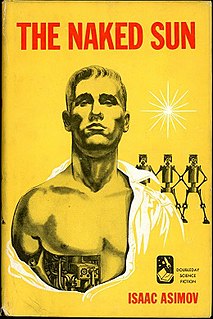 W
WThe City and the Stars is a science fiction novel by British writer Arthur C. Clarke, published in 1956. This novel is a complete rewrite of his earlier Against the Fall of Night, Clarke's first novel, which had been published in Startling Stories magazine in 1948 after John W. Campbell, Jr., editor of Astounding Science-Fiction, had rejected it, according to Clarke.
 W
WThe Crossroads of Time is a science fiction novel by American writer Andre Norton, first published in 1956 by Ace Books as one of their double novels. The story takes its protagonist through several versions of Earth as it might have been if history had gone differently. The book has been translated into Spanish, Italian, and German.
 W
WDanny Dunn and the Anti-Gravity Paint is the first novel in the Danny Dunn series of juvenile science fiction/adventure books written by Raymond Abrashkin and Jay Williams. The book was first published in 1956 and originally illustrated by Ezra Jack Keats.
 W
WThe Death of Grass is a 1956 post-apocalyptic science fiction novel written by the English author Sam Youd under the pen name John Christopher. The plot concerns a virus that kills off all forms of grass, including rice and wheat. Its publication in The Saturday Evening Post provoked considerable reaction amongst its readers on account of its portrayal of government's response to the unfolding worldwide crisis. The Death of Grass was the first of several post-apocalyptic novels written by Christopher.
 W
WDouble Star is a science fiction novel by American writer Robert A. Heinlein, first serialized in Astounding Science Fiction and published in hardcover the same year. It received the 1956 Hugo Award for Best Novel.
 W
WHighways in Hiding is a science fiction novel by American writer George O. Smith. It was published in 1956 by Gnome Press in an edition of 4,000 copies. The novel was originally serialized in the magazine Imagination in 1955. An abridged version was published by Avon Books in 1957 under the title Space Plague.
 W
WThe Man Who Japed is a science fiction novel by American writer Philip K. Dick, first published in 1956. Although one of Dick's lesser-known novels, it features several of the ideas and themes that recur throughout his later works. The "jape[s]" or practical jokes of the novel begin with a statue's unconventional decapitation.
 W
WThe Naked Sun is a science fiction novel by American writer Isaac Asimov, the second in his Robot series. Like its predecessor, The Caves of Steel, this is a whodunit story. The book was first published in 1957 after being serialized in Astounding Science Fiction between October and December 1956.
 W
WNo Man Friday is a British science fiction novel by Rex Gordon published in 1956. The reference in the original title is to Robinson Crusoe, and the story can be described as a science fiction robinsonade set on Mars. The similarity is made explicit by the first edition cover.
 W
WThe Power is a 1956 science fiction novel by American writer Frank M. Robinson. It first appeared in the March 1956 edition of Blue Book magazine and then in a standalone book published by J. B. Lippincott in May that year. Its protagonist, a researcher named Tanner, discovers evidence of a person with psychic abilities among his coworkers. As he tries to uncover the superhuman, his existence is erased and his associates murdered, until he faces a showdown with an apparently invincible opponent.
 W
WThe Shrinking Man is a science fiction novel by American writer Richard Matheson, published in 1956. It has been adapted into a motion picture twice, called The Incredible Shrinking Man in 1957 and The Incredible Shrinking Woman in 1981, both by Universal Pictures. The novel was retitled The Incredible Shrinking Man in some later editions.
 W
WSlave Ship is a 1956 short science fiction novel by American writer Frederik Pohl, originally serialized in Galaxy. The scene is a world in the throes of a low-intensity global war, which appears to be an amplified representation of the Vietnam War, in which the U.S. was just beginning to be involved. The plot involves telepathy, speaking to animals, and, in the last few pages, an invasion by extraterrestrials.
 W
WThe Stars My Destination is a science fiction novel by American writer Alfred Bester. Set in the 24th or 25th century, which varies between editions of the book, when humans have colonized the Solar System, it tells the story of Gully [Gulliver] Foyle, a teleporter driven by a burning desire for revenge.
 W
WStowaway to the Mushroom Planet is the second in the series of Mushroom Planet books by Eleanor Cameron, and was published in 1956, two years after The Wonderful Flight to the Mushroom Planet.
 W
WTime for the Stars is a juvenile science fiction novel by American writer Robert A. Heinlein, published by Scribner's in 1956 as one of the Heinlein juveniles. The basic plot line is derived from a 1911 thought experiment in special relativity, commonly called the twin paradox, proposed by French physicist Paul Langevin.
 W
WTo Live Forever is a science fiction novel by American writer Jack Vance, first published in 1956. In the Vance Integral Edition, it was retitled Clarges.
 W
WThe World Jones Made is a 1956 science fiction novel by American writer Philip K. Dick, examining notions of precognition, humanity, and politics. It was first published by Ace Books as one half of Ace Double D-150, bound dos-à-dos with Agent of the Unknown by Margaret St. Clair.